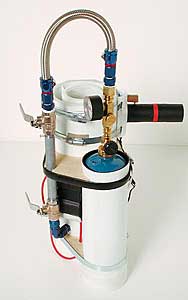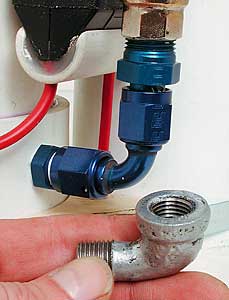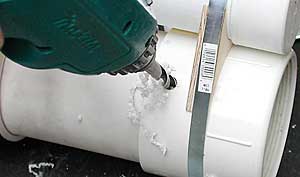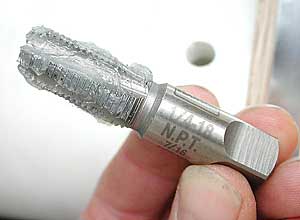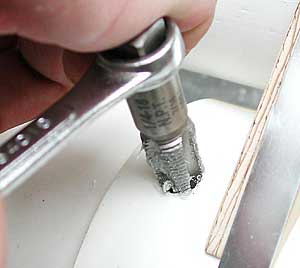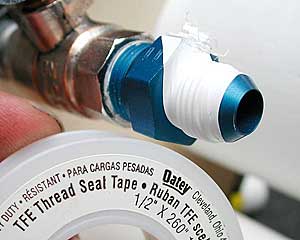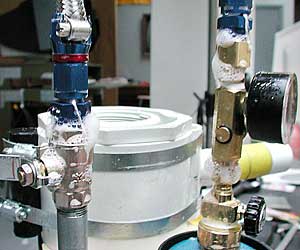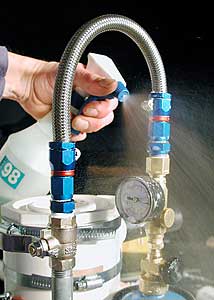|
Calculating the required volume of the meter pipe is easy but adding pressure to the equation makes it a little more involved. Temperature changes affect propane cylinder pressures greatly further complicating things. The trick is to find the sweet spot that works for the majority of conditions. This may require one meter be used during the summer and a larger meter during the winter or just use the larger meter year round and turn the pressure down during the summer. A variable meter design can provide stepless or incremental changes to the mixture.
The launcher pictured above currently uses a 3/8"x6" meter pipe. It provides a powerful charge that ignites every time. However, it is possible to charge this system twice and still get ignition some of the time. Can this system handle a larger meter pipe? Lets find out.
Measuring the chamber with water we find its' volume is 2,600 ml (cc). The correct amount of propane is 4% by volume so multiply 2600 by .04 to get 104ml of propane by volume required inside the chamber to mix with the air. US pipe fittings are sold in imperial measurements so convert 2600ml to 158.7cubic inches (cu.in.) for the chamber measurement. Convert the meter pipe measurement from 104ml to 6.35 cu.in. Now the pressure can be calculated into the equation.
The pressure of a new propane cylinder is said to be between 110 to 130 psi at room temperature. The regulator and gauge pictured here shows a pressure reading of 80 to 90psi when fully open. For the following calculation we will assume 90 psi. The atmospheric pressure at sea level is 14.7 psia, this converted atmospheric measurement is available at your local weather database. This atmospheric measurement is the pressure inside the chamber before adding the propane.
The formula used to calculate the meter pipe volume with pressure factored in is,
P1*V1=P2*V2
or: initial pressure*initial volume=final pressure*final volume
or: cylinder pressure*meter volume=atmospheric pressure*required propane volume
or: (90psi)(meter volume?)=(14.7psia)(6.35 cu.in.)
Multiply 14.7*6.35 to get 93.345 then divide this figure by 90 to get the required meter volume of 1.037 cubic inches. The launcher pictured uses a plumbing nipple as a meter pipe. Plumbing pipe and fittings have unusual and confusing naming conventions. For instance, the pictured pipe and fittings are labeled 3/8" but the inside diameter of the pipe is nearly 1/2" (0.46875"). Check the true ID of pipes and fittings before any calculations. To calculate the length of the meter use this formula,
(radius * radius) * pi * length = volume
or: (.234375 * .234375) * 3.14 * ? = 1.037
Re-arrange the formula to find the missing length,
volume / (radius * radius * pi) = length
or: 1.037 / (.234375 *.234375 * 3.14) = 6 inch meter at 3/8"(really 15/32") ID.
Remember that propane will only burn between 2.4% and 9.2% by volume with air. Too little or too much propane will not ignite. If this happens, carefully vent the chamber and go from there.
Just don't look in the chamber and pull the trigger to see what's going on.
An Excel spreadsheet for calculating propane meter volumes and sizes is available for download at the link below.
An online version, Fuel Tool Live, is also available.
download Fuel Tool 1.5e
Fuel Tool Live
|
